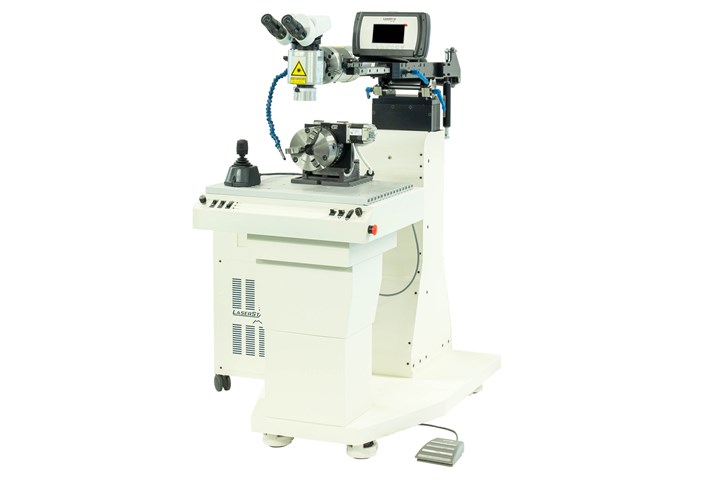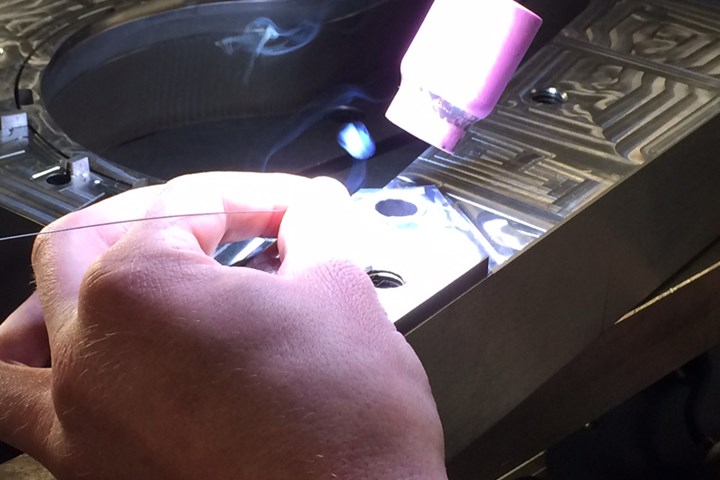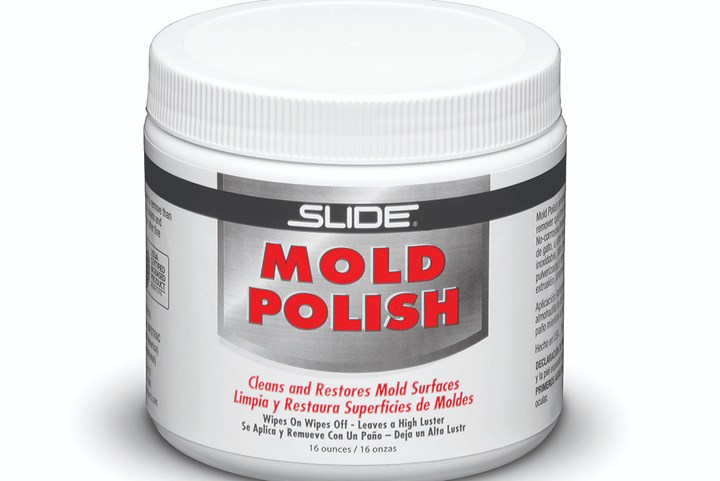MoldMaking Technology Noteworthy News, Jan. 06, 2021
The latest technology from High Tech Laser and Polishing, LaserStar Technologies, Precision Laser Technology, and Slide Products
Laser and Polishing Service Offered as One-Stop Shop for Customers
High Tech Laser & Polishing is ideal for a wide offering of laser welding, polishing and laser engraving amenities to save on shipping costs and reduce lead times.

Photo Credit: High Tech Laser & Polishing
High Tech Laser & Polishing’s (HTL&P) wide range of services assist customers with mold surface repair projects while saving on shipping costs and lead times. The one-stop shop is ideal for laser welding, polishing and laser engraving amenities; HTL&P can laser weld mold components, blend down the weld and polish the area to match the existing surface. The core (shown above) is an example of a component High Tech has repaired.
Under its laser welding offers, HTL&P can perform engraving, texturing, etching, cutting, annealing, drilling and welding services. The company’s deep engraving capabilities for the moldmaking and industrial market, for example, enables the company to mark logos, part identifications and bar codes on a variety of metal materials, graphite, wood and acrylics. HTL&P’s lasers can engrave 0.070 inches deep and deeper into hardened tool steels. Under texturing, High Tech Laser applies textures by using the various gray scales within the artwork in a 3D pattern, saving preparation time. The company can also laser texture an EDM finish or match an existing texture pattern.
High Tech also offers a versatile service offering under polishing. This includes diamond, paper, stone and brushed finishes, as well as abrasive blasting, lapping finish and vibratory tumbling. All finishes specified are also offered with the SPI finish chart according to the tool and die industry.
Finally, the company offers laser welding—an effective method for joining small parts with tight tolerances—and micro tig welding services, which is a speedier welding option for weld build up, waterline repair and shutting off or relocating runners on larger molds.
Manual Fiber Laser Welding Workstations Enhances Laser Precision Quality
The manual FiberStar 8800 Series and FiberStar 8900 from LaserStar Technologies offers a versatile range of common welding and material applications.

The FiberStar 8800 series. All photo credit: LaserStar Technologies
The FiberStar Series manual laser welding systems for precision welding operations from LaserStar Technologies Corp. are ideal for a variety of common welding applications. This includes plastic injection mold, dies and tooling repair, complex electronic components, high-precision industrial assemblies, pressure-sensitive hermetic laser sealing and other industrial applications for the automotive, aerospace, aviation, medical device, mold repair and consumer product industries. In particular, the FiberStar 8800 Open Laser Welding Workstation and are covered below.
For both workstations, operators hold parts in their hands while viewing the application through a stereo-microscope in the welding zone. An internal cross-hair allows the operator to easily align and weld the parts at the correct location.
Within the FiberStar series, the laser source is a permanently sealed design that protects against dust and dirt, does not require adjustment, has no consumable parts and requires no maintenance, resulting in stable, consistent material processing. According to the company, the laser resonator technologies provide high peak power, optimal performance and throughput, higher uptime, enhanced electrical efficiency and a space-saving, air-cooled design. Solid state diodes provide instantaneous power with no “warm-up time” required.
Multiple power options are also available (150, 300, 450 Watts). In addition to spot, seam, mold repair, micro and battery welding, materials such as 300 and some 400 series stainless steel, mild steels, nickel and nickel alloys, aluminum and aluminum alloys, titanium and precious metal alloys can be laser welded with these workstations.

FiberStar 8900 series.
The FiberStar 8900 CNC Welding Workstation, specifically, produces a sharp, focused light beam that consistently melts a very small area of metal. Very little heat is generated at the weld point, allowing users to easily laser weld greater than 0.025 mm from complex, heat-sensitive, intricate parts while providing unparalleled pulse stability of /- 1%.
Further, this laser is said to offer a competitive advantage for today’s operators looking to unleash the power of hot light, benefit from a comfortable, ergonomic design and ensure optimal platform flexibility for the widest range of onsite mold repair welding applications.
Precision Laser Technology Offers Unmatched Global Laser Engraving Services
Texturing, engraving, welding and direct part marking are just a few services PLT offers mold builders. An experienced team and enhanced technologies ensure unmatched quality, precision and speed.

Photo Credit: Precision Laser Technology
Service provider Precision Laser Technology (PLT) supports global mold builders with a wide range of laser services including texturing, engraving, welding and direct part marking. PLT also offers laser and Micro-TIG applications and staffs an experienced team knowledgeable in a wide range of tooling metals, alloys and corresponding fillet wires. PLT’s laser stations range up to 400 watts (W) and are optimized with multiple axes systems, boom extensions, CNC programming and tilting and swiveling optics in order to respond quickly to the next welding emergency that enters their doors.
Mold Engraving Services
PLT offers the etching of precision details and surface finishes for low and high cavitation molds. PLT can apply this service to tool steels (including hardened) aluminum (including QC10) copper (beryllium and Moldstar) and graphite. Engraving depth range from <0.001-0.125 in., with a tolerance of +/- 0.0005 in. Additional capabilities include sidewalls and contoured surfaces, 3D engraving, five-axis control, high cavitation and laser texture and polish.
Engraving detail options include:
- 2D and 3D logos and graphics
- cavity ID’s
- date codes
- recycle and material codes
- vent lines
- tool identification
Direct Part Making (DPM) Services
PLT permanently laser parts with product information including serial numbers, part numbers, date codes and barcodes, allowing for the tracking of parts throughout their life cycle. The company’s laser technologies can mark metals, plastics and surface-coated materials with increased marking speeds that yield shorter turnaround time and draw greater precision for enhanced quality. PLT’s DPM services meet NASA-STD-6002, MIL-STD-130 and ATF 27.CFR.478.92 industry compliance standards.
Anodized aluminum, for example, serves as a protective coating and hardener for fabricated aluminum parts. As an add-on, the ability to dye the anodized layer offers a contrasting backdrop for laser markings. PTL’s laser technology is programmed to remove the anodized coating and aluminum oxide to expose the material's surface. The interaction between the laser and the aluminum creates a bleach white mark that is highly visible against black and other colored anodizing.
Marking stainless steel is achievable using the proper laser source and power settings to provide a dark contrasting mark that is highly visible. Varying grades of steel respond differently and yield distinct shades of black. If desired, a permanent pigment could be introduced to provide color enhancement for a darker shade.
For applying aesthetic, permanent features on plastic, laser marking has become an alternative from existing printing and silk-screening applications. Within the plastic, the laser's radiation is absorbed by the polymer and converted to a thermal energy. Given the vast portfolio of plastic make-up, this thermal energy will react in a variety of marking fashions on the surface.
In addition to plastic, aluminum and steel, this service can be applied to copper, brass, titanium, wood, acrylic, zinc and rubber. Marking detail offerings include 2D and 3D, barcodes, logos and graphics, product data, lot and date codes and serialization.
Laser Welding
PLT offers Laser Deposit Welding services for the repair of mold components. The company’s laser welding systems are equipped with tilt adjusting optics allowing the laser beam to target vertical surfaces and complex areas with reduced set-ups. PLT’s laser welding technology maintains a low energy beam to a precise heat-affected zone. The localized heat and rapid cooling process minimizes any thermal overload to the work piece and excludes the need for pre-heating.
With the use of different pulsation methods and low heat control, PLT also provides precise laser beam control for spot welding and micro joining of advanced materials. Its automatic welding operations make for efficient production processes with higher control and repeatability.
Types of tool material for laser welding include S7, H13, P20, 420 SS, 440 SS, A2, D2 and M2, aluminum (including QC10), copper (including Moldmax and Moldstar) and ELMAX.
PLT also provides a mold repair form for a streamlined process.
Precision Laser Technology Team
Further, PLT’s core values of quality and service are embraced by an experienced, dedicated team that possess the training and knowledge to ensure a successful, timely and well-communicated weld repair.
PLT maintains a staff of highly qualified technicians to provide immediate solutions and recommendations to your engraving needs. Their service and support team additionally provide same day cost estimates and lead times; technical telephone support; project consultation; graphic enhancement and proofs; and engraving samples for customer assessment.
Bio-Based Mold Polish Offers Low VOC Count
The Slide Mold Polish formula effectively cleans mold surfaces. Non-hazardous and non-corrosive, the polish wipes on and off without leaving a residue.

Photo Credit: Slide Products Inc.
Plate-out, oxidation and stains on fine tooling surfaces can now be removed safely, quickly and cost-effectively with a new Mold Polish from Slide Products, Inc. Ideal for all types of metal molds, Slide Mold Polish restores surface finish, while providing a high luster sheen. Further, the USDA-certified, bio-based product has extremely low volatile organic compounds (VOCs), making it better for the environment and meeting regulations on VOC emissions.
Compared to competitive products, Slide says its Mold Polish is easier to remove than other polishes, and wipes on and off without leaving a residue. Applied with a soft cotton cloth or buffing wheel, it cleans and shines surface cavities and cores stained during plastics processing or fabrication. The new polish has proven effective on steel, stainless, aluminum, brass, bronze, zinc and other metals.
Non-hazardous and non-corrosive, it cleans and shines diamond-finished molds safely, without causing spiral webs, cattails or other fine surface scratches. Made in the U.S., it comes conveniently packaged in 16 oz. tubs.
Rust Preventative Spray Formulated With Food-Approved Active Ingredients
NSF registered H-1, Slide Products’ White Rhino is ideal for molding operations requiring food-approved ingredients, including medical molding.

Photo Credit: Slide Products Inc.
Slide Products Inc. highlights White Rhino, an NSF-registered rust preventive NSF H-1, which helps processors meet their molding requirements. Containing no trichlorethylene, the rust preventative is ideal for molding operations requiring food-grade active ingredients including medical molding, and offers up to two years of protection under normal operating conditions.
White Rhino’s dry formulation neutralizes fingerprint acids and is self-cleaning and self-healing. When applied, it sets up quickly to offer immediate protection against moisture and light acids. Maximizing productivity, White Rhino will also satisfy American Institute of Baking (AIB) audit requirements.
White Rhino joins a wide range of Slide products which also meet processor needs for food-approved active ingredients, including Slide’s Super Grease lubricant, mold releases and mold cleaners.
Read Next
How to Use Strategic Planning Tools, Data to Manage the Human Side of Business
Q&A with Marion Wells, MMT EAB member and founder of Human Asset Management.
Read MoreReasons to Use Fiber Lasers for Mold Cleaning
Fiber lasers offer a simplicity, speed, control and portability, minimizing mold cleaning risks.
Read MoreHow to Use Continuing Education to Remain Competitive in Moldmaking
Continued training helps moldmakers make tooling decisions and properly use the latest cutting tool to efficiently machine high-quality molds.
Read More

















